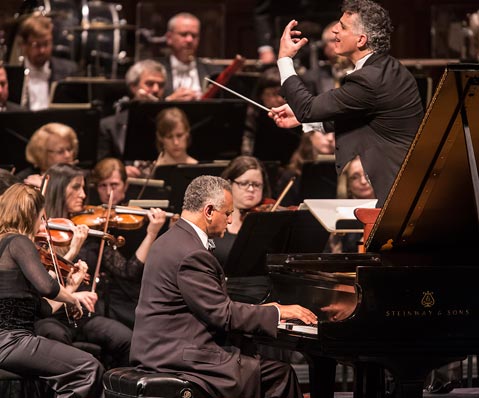Santa Barbara Symphony at the Granada Theatre
The 60th Anniversary Season Opened with André Watts on Sunday, October 21

The Santa Barbara Symphony under maestro Nir Kabaretti has gone a long way toward renewing the kind of faith and enthusiasm for orchestral music that Americans felt in the early 20th century. The journey ahead remains a long one, and the goal is to go not back to the past but rather forward to the future with the values, excitement, and quality of a major symphony orchestra somehow intact. On Sunday, the symphony began its historic 60th-anniversary season with “The Star-Spangled Banner,” and everyone, old and young, stood to acknowledge the patriotic connection we all feel whenever the national anthem is played. I even heard one grateful woman behind me comment, sotto voce, that “it’s nice they played it in a key I can actually sing.” Following this traditional moment, the orchestra launched into the Santa Barbara Overture of Emma Lou Diemer. This eight-minute composition from 1995 was written expressly for the Santa Barbara Symphony, at that time under the baton of Gisèle Ben-Dor, and it is full of lively references and clever motifs designed to bring out various features of our town. The bells of the Mission come through clearly, as does the pathos of Native American music treated in a manner derived from Duke Ellington. The entire piece explores the notion that arriving in Santa Barbara constitutes a kind of latter-day deliverance out of the negativity and confusion of other places. The work went over well with the audience, who were relieved by its relative accessibility within the general framework of contemporary compositional practice.
Next came the Symphony No. 5 in C Minor, Op. 67 of Ludwig van Beethoven, and the orchestra sounded wonderful, effortlessly bringing out the dancing lightness and intelligence of the score rather than pushing too hard on the dynamics. Strong but melodic, this was Beethoven for the 21st century, purged of the sorrowful and perhaps overly dramatic associations it acquired in connection with the Second World War and filled with an almost Mediterranean spirit and light.
After the intermission, the orchestra returned to the stage accompanied by guest pianist André Watts. The entire second half of the concert was devoted to Sergei Rachmaninoff’s monumental Piano Concerto No. 2 in C Minor, Op. 18. Again the dynamics of the piece were pared down in favor of fluidity and precision, with the orchestra and the soloist blending beautifully rather than competing for attention. Maestro Kabaretti demonstrated an excellent knack for matching the orchestra’s tonality to that of the piano, and Watts played with ease and panache. His phrasing turned each of Rachmaninoff’s melodic episodes into miniature narratives: playful, discrete, and highly sophisticated. This music has been condescended to primarily because of its popularization as a ubiquitous influence on film scores, but here, played with such taste and confidence, it sounded almost modern. Although it never became noticeably audible, one could still see that Watts engages in a certain amount of singing along as he plays; his mouth moved constantly during several of the more virtuosic sequences. This uninhibited attitude indicated abandonment to the experience, and it was contagious. When he stood to acknowledge the applause that swept the room at the piece’s conclusion, the majority of the audience did, as well.



